Alumni
For more information about alumni relations at Western Science, please contact:
Karmen Ferraro
Senior Development Officer
Email:karmen.ferraro@uwo.ca
Alumni and their Perspectives
Western Science Alumni - more than 40,000 members of the Western Science community - are contributing every day and in extraordinary ways to societies
Featured Science Alumni Story:
Transforming Fast Food: The Plant-Based Revolution Led by Odd Burger’s James McInnes
 James McInnes, Co-Founder and CEO of Odd Burger is an accomplished entrepreneur and scientist who has been vegan for more than 11 years. His journey from a Western Science student to a successful entrepreneur showcases the impact of his education and experiences. During his time at Western, James excelled in his studies, graduating with a B.Sc. in Honors Genetics (Major) and Computer Science (Minor). However, it was after graduation that he embarked on his entrepreneurial journey.
James McInnes, Co-Founder and CEO of Odd Burger is an accomplished entrepreneur and scientist who has been vegan for more than 11 years. His journey from a Western Science student to a successful entrepreneur showcases the impact of his education and experiences. During his time at Western, James excelled in his studies, graduating with a B.Sc. in Honors Genetics (Major) and Computer Science (Minor). However, it was after graduation that he embarked on his entrepreneurial journey.
Odd Burger Corporation is a 100% vegan plant-based food technology company. Their mission is to offer delicious food made from scratch, promoting healthier and more sustainable eating habits. With smart kitchens utilizing state-of-the-art cooking technology and automation solutions, Odd Burger is revolutionizing the fast-food industry.
James attributes his success to his education at Western University, where he honed his critical thinking skills. He believes that his ability to analyze situations in a data-driven way has been instrumental throughout his career. Reflecting on his time at Western, James recalls the vibrant campus culture and the facilities that enriched his university experience. "Having that work-life balance was an incredibly important part of my Western experience," he says. James enjoyed spending time at the gym, playing squash, and socializing at campus bars and restaurants.
"One of the most valuable aspects of my university experience was the relationships that I formed with my professors. It was invaluable and something I still cherish," James emphasizes. These connections proved extremely important and useful in shaping his future aspirations. "Once I started my career, I did a number of research projects and collaborations with some of my old professors, which was a really cool full-circle moment for me.”
More Science Alumni Stories
Meet Danny Chang (BSc'20)
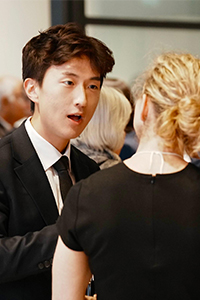 When Danny Chang (BSc‘20) sees an opportunity, he grabs onto it.
When Danny Chang (BSc‘20) sees an opportunity, he grabs onto it.
A student of physics and economics, Chang jumped at several extracurricular opportunities early in his time at Western—first joining the University Students’ Council (USC) and its provincial partner, the Ontario Undergraduate Student Alliance (OUSA), and later getting involved as a Faculty Soph and as President of the Science Students’ Council. Chang would grow from these experiences advocating for his peers, working on issues like rapid transit, student financial aid, and textbook affordability. He later took a year-long break from his studies when he was elected as VP and President of the USC and OUSA, respectively.
All of these experiences, along with an interest in emerging technologies, led Chang to co-found Delphic Research in 2020 with fellow USC Alum and former Chief of Staff to Ontario’s Minister of Health, Jason Grier. Delphic Research is an information monitoring platform specific to government affairs. Chang recalls, “Jason and I had met through the alumni network. After he exited his last company, he told me about the information challenges he had hoped to solve in government affairs, a problem I came to know well in my time lobbying the government on behalf of students. When he asked me to start the company with him, I answered a, frankly very scary at the time, call to adventure. And it was the best decision I could have made for my career.” This past summer, Chang and Grier closed $1.1 million in funding.
Chang was Delphic Research’s growth leader and wore a number of hats from sales to product development. Working with a lean team, he was comforted by the fact that he wasn’t the only one who felt intimidated by the challenges ahead.
Recently, Chang was given the opportunity to join another high-growth venture as Director of Strategy at Voyce , a company that connects non-English speakers to medical interpreters on-demand. “Voyce’s mission is to eliminate language barriers for our most vulnerable. As the son of a Korean interpreter and as an immigrant in North America, this opportunity is deeply personal and very exciting,” shares Chang.
Although Chang is not working directly in a scientific role, his time at Western Science has helped him be successful. “Problem-solving skills and understanding the scientific method are much more transferrable than you think.”
Chang’s advice for science undergraduates is to focus on how they can demonstrate the value they bring through their own unique stories. Additionally, gaining real-world experience by going out and helping solve problems through opportunities like the Science Internship Program is crucial. Chang believes not enough students are aware of these opportunities or realize the impact of gaining professional experience during/in between their studies. He says, “You will inevitably change as a person during your formative undergrad experiences. So, why not try a few new experiences along the way?”
Meet Charles Lindsay (BSc'83)
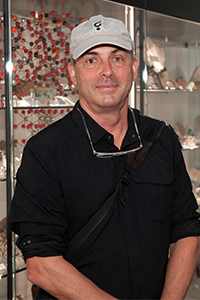
Charles Lindsay is driven by exploring out-of-the-way places. He says the pivotal moment was when as an Earth Sciences undergraduate student he took advantage of a Western program to place young geologists in the field. From that opportunity, he built on his curiosity to photograph wildlife in the Northwest Territories that then led him to become a photojournalist. The need to explore and delve into new ideas led him to become a globe-spanning artist whose discovery of a photographic process became the impetus to create an installation called “Carbon”. He is a Guggenheim Fellow and was the first Artist-in-Residence for SETI (Search for Extraterrestrial Intelligence) . Lately, his use of salvaged scientific apparatus has sparked conversations about the conflation of art and science. Lindsay visited Western in the summer of 2021 where he shared the story of his path from Western student to internationally acclaimed artist. We begin with Lindsay’s experience as a Western geology student and the opportunity he seized to open up his world.
After graduating with a BSc in Geology (1983) he continued his interest in seeking the far-flung areas of the globe where he literally pushed the boundaries and began his transition into the world of photojournalism.
After exploring environmental issues via photojournalism, Lindsay started experimenting with different photographic processes that led to him developing a new technique. His background as a geologist and appreciation of the aesthetics of crystallography coupled with multimedia and the insight to adopt new technologies enabled him to create the environment “Carbon”. Jill Tarter, one of the founders of SETI, took notice of the work and later invited Lindsay to become SETI’s first Artist-in-Residence
Lindsay currently engages himself with work that asks questions about the possibility of artificial intelligence becoming sentient and if so, can AI gain enlightenment? Can computers achieve a state of Zen? As Lindsay pushes the boundaries of where science meets art, he recognizes the need of the two paradigms to form the experience of being human. Lindsay uses salvaged scientific equipment and “Frankensteins” them into meditative pieces of art to shift our perspectives. Throughout all of his explorations, Lindsay says that while the finished works are gratifying, it is the process of creating that yields the most rewards.
Listen to the interview
Growth Beyond Grad with B4Grad: Meet Anthony Giugno (B.Sc. ’19)
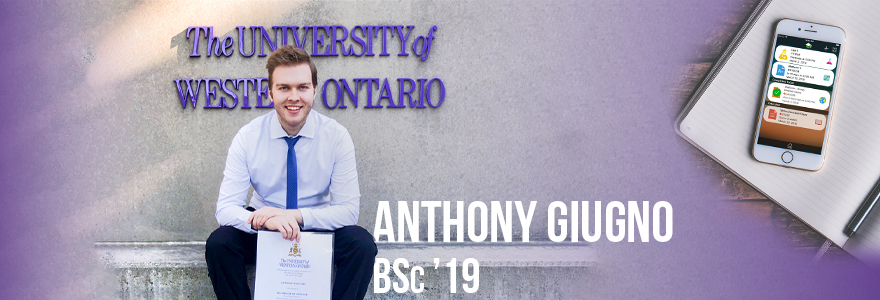
Unlike many of his peers, Anthony Giugno (BSc. ’19) ran in the opposite direction of established employers upon his graduation. Instead, he opted to start his own company, B4Grad , turning an undergraduate pet project into a full-time career. “I started building the B4Grad app in 2016 during my spare time. We didn’t have much in the way of learning about mobile app-building other than some software engineering classes, so this was a great way to build a skillset,” says Giugno.
His app is a one-stop shop for all things related to school organization. From a day planner and task-tracker, to being able to upload and organize lecture slides and notes, Giugno is hoping that B4Grad will become everyone’s trusty classroom companion. Having worked through a few business models, Giugno settled on a hybrid pay structure that allows users a limited number of free tasks before giving the option of a yearly subscription or a one-time outright purchase. Currently, B4Grad is entirely bootstrapped, meaning that growth has been fuelled by revenue alone, without external investment – something Giugno is hoping to change in the future.
“Early on, the challenge was finding time to work on the software platform,” explains Giugno, “I was pouring in time on evenings, weekends, and summer holidays, so in a sense, it’s a huge relief to have nothing else competing for attention now.” Currently, the free app, is at stage one of a three-stage development rollout; by fall, Giugno anticipates the platform will allow for students to create and share their own content, like flash card decks, attached files and images, and written notes from a tablet-and-stylus. “ Soon, users will be able to help each other out, for example if they missed a class, or didn’ t understand certain concepts. At exam time, peers will be able to combine and strengthen their class notes, appealing to all learning styles.”
“I remember celebrating B4Grad’s ninth download on my birthday. Now we have several hundred new users a day!” exclaims Giugno. With the newfound growth, he is looking to continue hiring new talent to help with the rapid upscaling of his technology. Giugno’s long-term vision is to see students of different universities sharing their knowledge across campus borders: “a first-year student at Western can learn to program in Python from a fourth-year at Waterloo,” he muses. The B4Grad team is compiling a database of academic calendars from English-speaking universities around the globe.
The academic world, very much Giugno’s oyster, has given the recent graduate much to reflect on about time spent at Western. “Watching my classmates go through the frenzy of sharing class notes, making flash cards, even getting in trouble for going about it in the wrong way – that’s what inspired me to find a better method for peer-to-peer sharing and organization. Starting B4Grad in the Western community gifted Giugno some unforgettable experiences. “I used to hand out flyers after class to try and find someone to help me co-found B4Grad. It was probably the most fun I’ve had making friends!”
While the pandemic rages on, e-learning platforms, like B4Grad are certainly here to stay. Giugno’s early-stage downloads are promising evidence that there are new opportunities in the EdTech space that are only just beginning.
Dr. Arthur Kwok, Part 2: The Next Wave
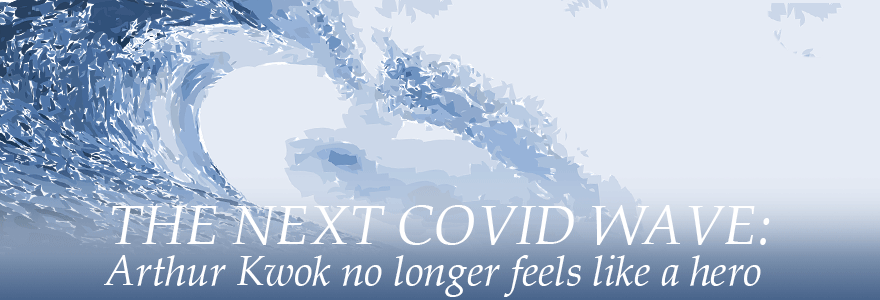
Arthur Kwok no longer feels like a hero. The dizzying highs and precipitous lows of being a newly minted MD in the midst of the world’s worst health crisis in a century and the emotions laid bare in his carefully written journal entries – all have faded into the past.
We last encountered the Western Alumnus in the late spring of 2020, leading a New Jersey hospital’s Covid-19 response as an ICU medical resident. An hour’s drive from New York City, which, at the time, was facing hundreds of deaths every day, Kwok was flush with the same exhilaration of a foot soldier on the front line.
“Now I’m frustrated. Things are only getting worse,” he says, bluntly. Despite a number of vaccines being rolled out in the US, Kwok sees a mountain to climb before the situation actually improves. “This winter will be deadly. I think people are dealing with pandemic fatigue, even throwing up their hands, and are resigned to being infected. Things aren’t going to get better any time soon.” To make matters worse, Kwok sees the spikes in cases after Thanksgiving and Christmas as inevitable consequences of people not getting the message. “The casinos in Atlantic City are still running full tilt.”
With the daunting task ahead, Kwok’s perspective in handling the surge has changed since his days as a resident at Rutgers University. He is now an attending physician and has moved to a hospital in Atlantic City, NJ. “I’m no longer being supervised by more senior physicians – I am the supervisor. I definitely feel a greater responsibility, though six months ago I doubt I’d have thought that possible” he remarks. As an admitting physician, Kwok sets the plan and tone of treatment for Covid-19 patients. Once the emergency room deems them in need of in-patient care, Kwok decides how best to combat the virus, often relying on steroids and sometimes the now well-known antiviral, remdesivir.
“The biggest difference between the spring of 2020 and now is that we have much more clarity on how to use steroids and antivirals to best treat people,” explains Kwok. By his account, the second Covid-19 wave is less severe in mortality than the first; far more people are infected but proportionally, people are less sick. Kwok credits the improved treatment schemes and lesser severity of the second wave with the better healthcare outcomes he sees in his hospital now.
Kwok regularly observes fatigue in his patients when before he saw terror; where hopelessness and exhaustion compound, he finds many either indifferent or reckless, leading to increased rates of infection in his community. To add to the mix, the advent of coronavirus vaccines lulls some into thinking that the end of the pandemic is near when in reality, the roll-out time will leave millions vulnerable for months to come.
Having given up on his daily Covid-19 journal entries, Kwok returned to a moment of written reflection when he received a vaccine just days ago:
15 minutes
The day seemed routine. I made my way over to the hospital where the vaccinations were being distributed. A sense of excitement and a buzz in the air. Familiar questions were asked. I was guided to a station – one of many set up. The nurse placed the loaded syringe in front of me. He was asking me more questions. “Have you had a fever...”, “Have you had a reaction before...”. Answering the questions almost subconsciously, I looked at the vaccine. So simple, mundane, routine looking. I had preconceived notions of a nurse presenting a vial to me, out of a freezer box with billowing dry ice. “Can you confirm your date of birth?..”. It looked like any other needle or vaccination. “Roll up your sleeve..” - And that was it. Over in a second. Barely a pinch. Certainly anticlimactic. “Please wait over there, for 15 minutes to observe for any negative reactions”, said the nurse gesturing to a socially distant arrangement of chairs. I sat down. Waited for 15 minutes. A time to reflect. Let it all sink in. What seemed so important, seemed so routine. A dichotomy of emotions.
A routine day
The pandemic wanes on
The death toll climbing
To protect those I serve
A stoic face
Over in a second
In service to the country
A duty
The beginning of the end
A light at the end of the tunnel
We remember those we couldn’t save
An emotional moment
We had waited an eternity
A privilege bestowed
An honor
“See you again in three weeks”. Back to the fight. Another day.
Many of Kwok’s patients ask him about getting vaccinated; if they do not bring up the topic, he opens the conversation himself. “I talk to my patients about their intentions. Often, we discuss their skepticism and health concerns.” What frustrates Kwok, above all else, is the misinformation and disinformation spreading online about the vaccine. “The global scientific community has achieved a monumental feat in creating and approving a vaccine within a year, yet so many are actively working against the closest thing we’ll get to a silver bullet,” he says. Almost exclusively, Kwok’s patients opposed to the vaccine refer to social media as their point of information on the subject.
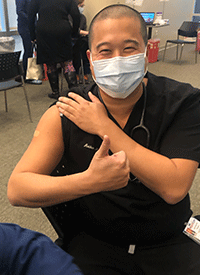 In response to the rampant falsehoods surrounding the vaccine, Kwok carries a pamphlet of Pfizer’s clinical trial data with him at the hospital. “I have daily interactions with people who are steadfastly against being vaccinated. Instead of confronting them, I present the information and other resources to encourage informed decision-making,” he explains. His gentle and non-judgemental approach often results in an about-face from headstrong skeptics. Kwok also posts on his Instagram about the vaccine to spread awareness amongst his friends and followers. “The top questions I get from my friends are about the vaccine’s effects on fertility, I think due to some unfounded reports that had circulated online. My reply is always that there is no evidence to suggest that the vaccine triggers a mechanism of any sort to interact with human reproductive organs,” says Kwok.
In response to the rampant falsehoods surrounding the vaccine, Kwok carries a pamphlet of Pfizer’s clinical trial data with him at the hospital. “I have daily interactions with people who are steadfastly against being vaccinated. Instead of confronting them, I present the information and other resources to encourage informed decision-making,” he explains. His gentle and non-judgemental approach often results in an about-face from headstrong skeptics. Kwok also posts on his Instagram about the vaccine to spread awareness amongst his friends and followers. “The top questions I get from my friends are about the vaccine’s effects on fertility, I think due to some unfounded reports that had circulated online. My reply is always that there is no evidence to suggest that the vaccine triggers a mechanism of any sort to interact with human reproductive organs,” says Kwok.
Months out from the heady days of a new career in the midst of a paradigm shift for global healthcare, Kwok has now settled into the grind. The journaling that once helped him make sense of a world turned upside-down has given way to open conversations with his colleagues. The now-routine nature of treating and surviving the pandemic means that families no longer send pizza lunches to the wards, fire brigades and police have stopped their brightly lit parades in front of the hospitals, and long gone are the days of neighbourhoods clanging their pots and pans together on their doorsteps. “Early on, every life we saved in a time of unprecedented chaos, felt like a windfall, a triumph, because we didn’t know enough about the virus. Now, though, the medical community has a better understanding, and society-at-large knows what it should be doing to keep each other safe. But, unbelievably, infection rates have never been higher. It feels like some people just don’t care.”
“I’m a family physician – built into this is the development of lasting relationships with my patients to ensure their long-term health. I look forward to the day when the healthcare I provide expands beyond firefighting to include preventative medicine so that I can contribute to my patients living their best lives. For now though, my world is consumed by Covid. And while my calling is to serve my community and help improve the lives of patients and their families, the endless onslaught of infections, symptoms, and deaths has muted the sense of individuality in the relationships I have with those under my care,” tells Kwok. “I still believe in what I’m doing. I continue to feel immense pride in serving my community. And make no mistake, my colleagues and I will not give up – the attack on our community will end first.”
Written by Sasha Madhavji
Dr. Arthur Kwok, Part 1: Surviving the Surge
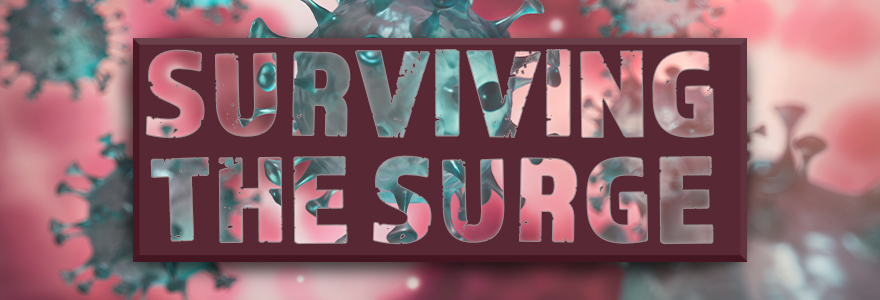
“No visitors” is both the title and the mantra repeated within Arthur Kwok’s journal entry, one of many the 3 rd-year medical resident has made since taking up as one of the lead physicians of the intensive care unit (ICU) at a New Jersey hospital. Dr. Kwok, a Western alumnus (BSc. ‘09, MSc. ‘12) and family medicine resident at Rutgers University, has been chronicling his experiences since shouldering the immense burden of leading the Freehold, New Jersey Covid-19 response.
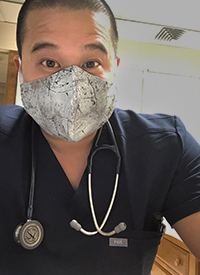 “When I get home, if I’m feeling overwhelmed, I put down some of what I experienced that day,” says Kwok. “No visitors” will weigh on Kwok for years to come – in the journal entry, he tells of palliatively removing ventilator support from a patient of his, an elderly woman not expected to survive Covid-19, to free up the life-saving device for another patient. “I asked her children if they would consider allowing this and they agreed on the condition that they could come see her before she passed away,” he says. Like with many hospitals, no visitors were permitted; Kwok directly contravened the rule to speed up the availability of the ventilator.
“When I get home, if I’m feeling overwhelmed, I put down some of what I experienced that day,” says Kwok. “No visitors” will weigh on Kwok for years to come – in the journal entry, he tells of palliatively removing ventilator support from a patient of his, an elderly woman not expected to survive Covid-19, to free up the life-saving device for another patient. “I asked her children if they would consider allowing this and they agreed on the condition that they could come see her before she passed away,” he says. Like with many hospitals, no visitors were permitted; Kwok directly contravened the rule to speed up the availability of the ventilator.
“I led the two sisters upstairs to the CCU. Stares of disapproval from some were melted away as they approached the room. They were not allowed in. But they mourned from the room door. Tears fogging up their face shields. A gloved hand on the CCU room window, reaching out to their deceased mother, but separated by the isolation. No visitors.”
He and his colleagues have been fighting a similar battle to their counterparts a mere hour’s drive away in New York City; “We got hit about a week later than New York and we’ve followed their trajectory pretty closely since then.” Despite his youth, Kwok has been managing his hospital’s 26-bed ICU, which has been facing a pitiless influx of Covid-19 patients. “There’s a significant experience gap if you compare a resident like me to a senior attending physician, but with the uncharted territory of Covid-19, we’re on equal footing in many ways,” he says. “In the early days there was an overwhelming uncertainty – how to treat patients, how to manage beds, ration protective gear and ventilators. There are still so many unknowns.”
As a Canadian in New Jersey, with his parents back in Toronto, Kwok would not be putting his loved ones at risk by being constantly exposed to the virus. From the moment his hospital knew they would be receiving a surge of Covid-19 patients, he volunteered to man the ICU. “How better to uphold the pledge I made as a doctor, than when my community needs me most?” The mid-sized ICU remained full from the start; “whenever a patient died, a new one was waiting to take the empty bed,” tells Kwok. “Ventilator availability was low, so we converted other breathing-aid machines to do the same job. I even looked into how patients could share a ventilator but thankfully that was never required.”
After the initial shock and high number of daily deaths, Kwok and his colleagues began to see some successes as treatments took effect and patients were
weaned off ventilator support. “There were a lot of patients dying at the beginning but we’ve now extubated dozens of people,” he says, “In a single day we even took a record six people off ventilator support!”
In a well-known New Jersey Covid-19 story, seven members of the same family were hospitalized; four succumbed to the virus. Kwok’s ICU treated several of them, and recently two of them, both young adults, were recently discharged after spending 30 days on ventilator support. Another memorable patient, a saxophone player from Bruce Springsteen’s backing group, was intubated for three weeks and on the cusp of needing a tracheotomy. A new treatment involving the blood plasma of a donor who had developed Covid-19 antibodies took hold within three days and he was discharged from the hospital shortly after.
Several weeks removed from the frightening surge of the pandemic, Kwok recounts his experiences with the matter-of-factness of one hardened by a relentless commute from frying pan to fire. “There’s almost a sense of normalcy now, and our hospital population is abating,” he says. “Making the difficult calls, speaking to patients and their families about end-of-life care – these are not unique to the pandemic. They are part of a family physician’s job.” Though Kwok is in the earliest stages of his career, he has he rapidly become comfortable with those agonizing conversations. “I have to remind myself that even though it may seem routine to me, much of what we deal with on a daily basis will be the worst memories of someone else’s life.”
The way Kwok envisions the road ahead of him has changed as a result of this pandemic. “Without question, facing Covid-19 as a resident has been formative,” he explains. “I feel a longing to focus my efforts on inpatient care rather than in a clinic setting.” Kwok has recently signed a contract to stay in New Jersey and carry out this calling in a community he describes as “unbelievably supportive.”
“The response from patients, family members, and local residents has been incredibly uplifting. Letters from children, drive-bys from the fire and police departments, pizza lunches – I’m overwhelmed by the gratitude and I won’t be able to look at a slice of pizza again!”
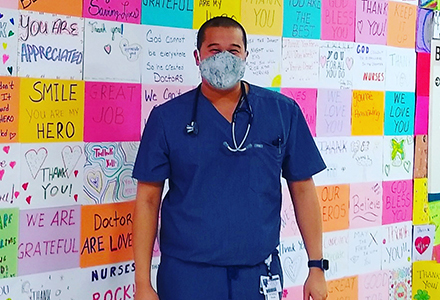 In Kwok, Covid-19 has reinforced the central role of empathy in medical care, and nowhere is that deep-rooted sense of feeling better explained than in the journal entries written in his most vulnerable moments. “It’s therapeutic. I live alone, and far from my family, so my journal entries helped me organize my thoughts at a time when the world around me didn’t make sense,” says Kwok. As his state eases restrictions on people’s movements, Kwok is gearing up for a second wave of cases in his ICU. “I’ll be better prepared to handle these cases on a personal level, and the outpouring of support from colleagues and community reminds me, every day, why I love my job.”
In Kwok, Covid-19 has reinforced the central role of empathy in medical care, and nowhere is that deep-rooted sense of feeling better explained than in the journal entries written in his most vulnerable moments. “It’s therapeutic. I live alone, and far from my family, so my journal entries helped me organize my thoughts at a time when the world around me didn’t make sense,” says Kwok. As his state eases restrictions on people’s movements, Kwok is gearing up for a second wave of cases in his ICU. “I’ll be better prepared to handle these cases on a personal level, and the outpouring of support from colleagues and community reminds me, every day, why I love my job.”
This is the first in a series of three Science Communications articles that will capture the experience and sentiment of a Faculty of Science alumnus, Dr. Arthur Kwok, over the course of the COVID-19 pandemic. Stay tuned for: The Next COVID Wave and The New Normal in a COVID-19 ICU.
Dr. Whitney Dillon sends message from the front lines (Western News)
Like many physicians, I decided on a career in medicine – more specifically family medicine – because I like to get to know my patients, helping them through happy and tough times. I like to work collaboratively with my team of nurses, dieticians, social workers and medical assistants to manage the health and wellbeing of my patients.
To Dr. Whitney Dillon (BSc’08) a typical day may include meeting a 2-day-old newborn, supporting a grieving spouse, making a house call to a patient over lunch, removing small skin cancers or helping to coordinate care for my complex patients.
Then March 2020 happened. Read what happened next (via Western News).
Ali Fathi Baghbadorani
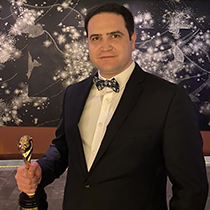 Ali Fathi Baghbadorani (PhD ‘15, MSc ‘16) took the scenic route through academia before joining the Royal Bank of Canada (RBC) and becoming its most recent recipient of the Leo Award. Given to the 80 top performers in a company of 80,000 employees globally, the Leo Award gleaming on Ali's shelf signifies the culmination of a five-year endeavour at RBC to mobilize an impressive skillset constructed and honed at Western.
Ali Fathi Baghbadorani (PhD ‘15, MSc ‘16) took the scenic route through academia before joining the Royal Bank of Canada (RBC) and becoming its most recent recipient of the Leo Award. Given to the 80 top performers in a company of 80,000 employees globally, the Leo Award gleaming on Ali's shelf signifies the culmination of a five-year endeavour at RBC to mobilize an impressive skillset constructed and honed at Western.
Growing up in Iran, Ali always loved math; he completed his undergraduate and masters studies in math (the latter in Tehran) before moving to Canada in December 2010 with his new wife to begin a PhD under Masoud Khalkhali in the Department of Mathematics. London locals will not soon forget that winter, lovingly dubbed Snowmageddon by the Western community. “We got married a couple weeks before moving to Western so Canada was our honeymoon – when we arrived the city was shut down and under a ton of snow!” exclaims Ali. While the shocking reality of winter in the Ontario snow belt subsided, Ali began to search for a career outside of academia where he could apply his background in math.
“I finished my PhD with a headful of philosophical questions,” says Ali, “most significantly, I wanted an extroverted career where I could work with people in a more applied and interactive setting.” Enter Matt Davison and the field of quantitative finance. “Believe it or not, I went back to do a masters after finishing my PhD,” says Ali. Under the supervision of Davison, in the Department of Statistical and Actuarial Sciences, Ali was immersed in a setting where he could combine his decade’s worth of math education to large-scale computational statistics, asset pricing in capital markets, and predictive modelling of financial behaviours. “Specifically in the area of predictive behavioural modelling, you need a lot of two things: data and computing power. The last five years have seen an explosion of both,” explains Fathi.
It is through his work modelling that Fathi won the Leo Award from RBC. “I joined RBC after finishing at Western to work on predictive modelling of stressful economic situations,” explains Ali; “Our models focussed on when people make deposits, withdrawals, credit card payments, and certain mortgage behaviours.” With billions of (anonymized) data entries, conditions were ideal to apply machine learning tools to try and predict how financial portfolios behave under certain conditions. “I was given a lot of latitude to explore ideas on how to implement analytical artificial intelligence (AI) methods,” says Ali. Ali credits his post-PhD masters with getting him the relevant exposure to advanced statistical methods which underpin his pioneering machine learning models at RBC.
“When I think of my time in academia, I was so well cared for throughout,” reminisces Ali; “A changing cultural context can leave you feeling vulnerable but the Western community, beginning with my supervisors, nurtured us and helped build up our self-esteem.” Ali's wife, whom he met during graduate studies in Iran, is now a medical student at the University of California, San Jose. Outside of banking, Ali’s life is music and sports. A Pink Floyd superfan, Ali is also learning to play the pan flute, an instrument similar to a traditional Iranian flute of his early life, called the ney. Having grown up with easy access to mountains in Iran, Ali has always been an avid climber; “unfortunately there are no mountains nearby, but I definitely think the coolest place to hang out in London is the Junction climbing gym,” he laughs. In winning the Leo award, RBC has recognized Ali’s vision and expertise, something he is quick to attribute, at least in part, to his relationships with his supervisors, peers, and the wider community at Western.
Natalie Abeysena
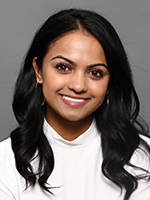 Curiosity most certainly did not “kill the cat” for Natalie Abeysena, Western BSc. ’15 graduate and co-founder of
Curiosity most certainly did not “kill the cat” for Natalie Abeysena, Western BSc. ’15 graduate and co-founder of
Her undergraduate coursework in cognitive neuroscience engendered in Natalie a love of curiosity, and the merits of exploring uncharted ideas. “I started with an interest in the medical aspect of neuroscience,
Between third and fourth year, Natalie spent the summer in Rwanda teaching sexual education to school children, followed by an internship in Boston working with a firm specializing in using technology to augment learning for students with cognitive disabilities. For Natalie, the contrast between the classrooms of Rwanda and the US sparked a curiosity about the role of software technologies to make the learning experience more personalized. “At this stage, I had passed the point of no return and given in to my curiosity of learning tools,” says Natalie.
Following her degree at Western, Natalie doubled down on her interests at the nexus of education and technology by
Nearly two years into her start-up and Natalie is still driven by her curiosity. “Start-ups are risky but learning always turns into long-term value,” she says. ScopeAI builds software that analyzes customer conversations to help user-facing teams, such as support, uncover insights that can inform product decision-making. Aggregating different sources, such as customer service calls and online reviews, ScopeAI uses natural language processing to instantly generate trends from the data.
“To this day I follow my curiosity, which helps me rationalize risk-taking, but now I have to temper it with being responsible – after all, in the company setting, I have to be aware of my colleagues.” That said, Natalie still very much includes her explorative
“I could distill my experiences down to curiosity, focus, and patience. Balancing long-term, intangible goals with the tractable, short-term steps to get there is a great way to ensure your path forward.”
Raymond Francis
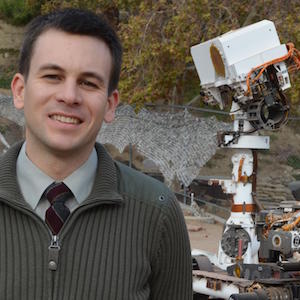 Dr. Raymond Francis jokes that the path that led to a fascinating role on the NASA Mars 2020 rover mission “looks like the outcome of a brilliant plan, but it wasn’t.” For Francis, it was more a case of being alert to opportunity, and answering opportunity’s knock – with Western as a launching pad.
Dr. Raymond Francis jokes that the path that led to a fascinating role on the NASA Mars 2020 rover mission “looks like the outcome of a brilliant plan, but it wasn’t.” For Francis, it was more a case of being alert to opportunity, and answering opportunity’s knock – with Western as a launching pad.
Francis is an engineer at NASA’s Jet Propulsion Laboratory (JPL) at the California Institute of Technology, where he is Science Team Training Co-ordinator on the Mars 2020 mission. He is also Adjunct Professor, Electrical and Computer Engineering at Western.
Being one of a handful of Canadians among nearly 7,000 people working at JPL is a dream come true.
As a child, Francis spent a lot of time building and sending Lego spacecraft on exploration missions. He vividly remembers reading about early real missions – Viking, Voyager, Apollo. He was captivated by the images of distant worlds and impressed by the people operating them. But how to become one of them? He didn’t know.
His best guess in high school was engineering. Sitting in a guidance counselor’s office, he spotted a course calendar from the University of Ottawa. Mechanical Engineering seemed full of exciting courses like thermodynamics, and it was a co-op program. He thought an engineering degree with work experience would probably lead to a job, and he would be studying interesting things, so he applied.
When opportunity knocks
After completing a Bachelor of Applied Science in Mechanical Engineering, Francis learned that the European Space Agency (ESA) had a program for new graduates. While most positions specified “master’s degree required,” one said the degree was merely “preferred.” Francis got an interview, thanks to his co-op experience. He was told to expect a call in four weeks.
Weeks passed. Francis decided if he didn’t get the job, he would go back to school for his master’s. An online search showed a Space Science program in the Physics department at the Royal Military College of Canada, and he applied.
Eight weeks after the interview with ESA, Francis learned he had both the job and acceptance at RMC. Spotting another opportunity, he asked the college if he would be an even better candidate with job experience at a space agency. They agreed.
Francis spent 14 months with ESA in the Human Spaceflight
Meanwhile, Francis had noticed a signal for his next step: he was one of just two people in his department at ESA who didn’t have PhDs.
While researching
Francis was the program’s first engineering
“I had seen scientists who didn’t understand what it takes to build technology, and engineers who didn’t know how the technology would be used to meet scientific objectives,” Francis says. “We all saw the value in someone who could bridge those worlds. I also had the goal of positioning myself, at the end of it, to have a better shot at working on a real exploration mission.”
Opportunity knocks again
Having one foot in engineering and the other in science, plus a few more grabbed opportunities, meant Francis was already working on Mars Science Laboratory (MSL) at the halfway point of his
Francis had also proposed another computer algorithm to autonomously interpret images of geological scenes. While attending a major planetary science conference at Osinski’s invitation, he noticed someone from JPL was presenting an abstract on a similar theme. Francis located that
Two years later, the same researcher hired Francis as an intern for a project related to rock outcrops. The core research there became part of his thesis. And the automated computer algorithm he developed led to an invitation to be a visiting post-doctoral fellow at JPL. As such, he worked with MSL’s ChemCam spectrometer and the Autonomous Exploration for Gathering Increased Science System (AEGIS) software system, which provides automated data collection targeting for remote sensing instruments on the Mars exploration rover.
At that point, Francis was splitting his time between JPL and Western, where he supported
This and NASA recognition for exemplary work in planetary science and engineering led
to his current role. He’s working to train the Mars 2020 mission science team, who will explore and collect samples on Mars with a new rover currently being built.
Careers as marathons, not sprints
There’s no fast track to the career Francis has built for himself. Between the various academic programs and work, more than a decade passed since he left high school.
But that diverse education and rich experience through an unusual path
“Now, I’m trusted to develop and operate those missions of exploration on distant worlds I dreamed about as a child,” Francis marvels. “It’s definitely a dream come true.”
Dr. Raymond Francis is Western’s Adjunct Professor, Electrical and Computer Engineering, and an engineer at NASA’s Jet Propulsion Laboratory. There, he is the Science Team Training Co-ordinator for the Mars 2020 rover
Francis works with the Mars 2020 Project Science Office to train the team to explore Mars with its upcoming rover. He takes one or two days a week to work in science operations for the Mars Science Laboratory mission. There, he operates the Curiosity rover’s ChemCam instrument, used to measure the geochemical composition of rocks on Mars, or plans geological or atmospheric experiments to be carried out by the rover. He is also the lead system engineer for autonomous science operations with the AEGIS software system.
Francis spent 14 months with the European Space Agency (ESA), preparing experiments for the Fluid Science Laboratory aboard the International Space Station. He previously led the system engineering and operation of stratospheric research balloon experiments at the Royal Military College of Canada.
Francis holds a
Amanda Holden
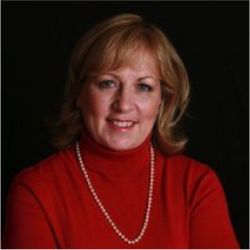 It’s early on a Thursday morning and Amanda Holden has already met with members of her team, grappled with at least one issue and is now sharing her time, experience and a story to inspire and inform the next generation with Science Speaks.
It’s early on a Thursday morning and Amanda Holden has already met with members of her team, grappled with at least one issue and is now sharing her time, experience and a story to inspire and inform the next generation with Science Speaks.
The daughter of an engineer, with a strong aptitude in the sciences, Amanda was expected to pursue a Science degree, so when she announced the intention to take up a major in arts, her family was awestruck. Inspired by a grade 13 visual arts teacher, she was determined to explore the artistic hues of her creative potential. While the experience was interesting, it was also short-lived. Holden came quickly to realize that her chosen career path would be paved on a Science foundation while being
The subsequent decision to focus on computer science was the result of an open and curious mind. Amanda experimented with different types of courses in physics, computer science, and math and discovered that she was challenged by the strategic thinking required to develop code – not any code, rather elegant and efficient programs; the type that would land her multiple job opportunities right out of school.
Stay close to home and work for an oil company. Move to the nation’s capital and support a research
Amanda chose TD because “they focused on the human side of the work,” an impassioned Holden said. They understood that while educated and technically skilled, new graduates needed to learn about the work context – how to stand on their own in a large corporate structure; the standards, policies; practices; tools and techniques specific to TD in order to be successful. This firm was prepared to invest in her transition from the world of academics to the working reality of corporate Canada and she reciprocated over the next ten years with focus, lateral and vertical growth and loyalty. Fast forward almost three decades since Holden graduated from the Faculty of Science as one of six women in the field of computer science, she is now the Solutions Executive and National Practice Lead for Fraud and Security Intelligence for SAS Canada.
Staying Current
That technology continues to evolve at a breakneck pace requires everyone, not just experts in the field, to find ways of remaining current. The challenge cautions Holden, is compounded as you move up the corporate ladder and have progressively less time and hands-on experience with new technologies but more responsibility for selecting and justifying the upgrading or replacement of existing systems while ensuring the correct alignment between select technologies and business needs.
Amanda addressed the issue by regularly attending technology-focused conferences where she developed and leveraged partnerships with credible technology industry experts who provided consistent, accurate and therefore very valuable technology trends and best practices. Holden also invested heavily in other discipline-specific professional development, signing up for courses annually, focusing primarily on developing skills in management-related disciplines – human resources,
Leadership
The expectation of leadership, “begins the day you walk into the office,” says Holden. It disregards your gender, title or even experience. It is demanding, unrelenting and may be the greatest challenge most people encounter in the workplace. Forbes.com defines leadership as a process of social influence, which maximizes the efforts of others, towards the achievement of a goal. While the definition is clear, it’s
The Bay Street veteran believes that leadership begins with humility – with the
Creating that win-win situation for her employees and
Amanda is a Solutions Executive and National Practice Lead for Fraud & Security Intelligence for SAS Canada. She is responsible for driving business development and go to market strategies for SAS Fraud and AML products and services. As a national leader and evangelist, Amanda is focused on finding solutions to customers' financial crimes, loss and AML problems. She is passionate about data and analytics and the role they play in reducing financial crimes in Canada.
Prior to joining SAS, Amanda was the Technology Executive Sponsor for TD Bank's Enterprise Fraud Analytics Platform initiative. She led the technology build for a multiyear, integrated vendor solution, designed to support fraud practices from analytics, model development, fraud countermeasures/scoring to alert management, operations and reporting. The solution services multiple lines of business (retail & commercial, internal & external, batch to real-time processing).
Amanda has over 15 years of experience in the Payments industry with a focus on fraud operations. As VP-OPerations, Security, Technology & Fraud at Interac Association, Amanda lead all technical, operational, fraud and security oversight for the Interac Inter-Member Network and payment services such as Interac e-Transfer. Ananda was responsible for the development, delivery
In her earlier career, Amanda was Vide-President, Operations at Visa Canada. She was responsible for all operational, fraud and MIS functions for the Canada region including service delivery, network and technology support, project and implementation management, production support, client services, fraud management and information systems, Amanda has also held other technology solutions roles in the financial services industry.
Amanda holds an Honors Bachelor of Science in Computer Science from the University of Western Ontario and a Certificate in Bankcard Management from the Visa Bankcard School. Amanda has a passion for analytics and technology, most recently focusing on enabling business and technology partnerships. She participates in
Peter Scheyen
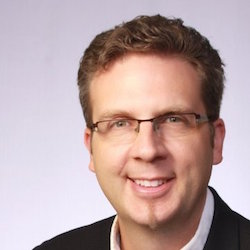 Peter Scheyen was just 13 when he fell in love with technology, thanks to a Commodore 64.
Peter Scheyen was just 13 when he fell in love with technology, thanks to a Commodore 64.
That first computer turned out to be an easy and accessible way to get into programming. It was also the driving force that sent him to an out-of-district high school because it had a rich computer science program, and then on to Western University. His undergrad included late nights working closely with classmates in a collaborative experience that shaped his passion for technology.
“That strong foundation in development helped me understand technology at
After finishing his Masters in Computer Science at Western, Peter stayed on in the department for two years as
Peter embraced the opportunity, although it involved no training.
“I learned by doing things wrong a lot of time, but in an environment where that was okay,” he says. “We were a bunch of developers all in it together, and it was such a collaborative experience, much like my computer science classes. That shaped my thoughts on leadership and how to build effective teams.”
When a Silicon Valley company bought VirtualModem, Peter became a manager. For a time, he thought he needed to start “acting like a manager,” parceling out and tracking work. But he found it frustrating. It wasn’t
“Asking a developer how long it will take to create some software is like asking an author how long it’s going to take to write a book,” he says. “There’s no formula.”
It didn’t take long to figure out that a predictive, controlled approach wasn’t going to work. Peter knew that the right leadership would make the work environment better, morale would go up and the team would be more productive. Around that time, he got interested in “agile” software development, and he’s been honing that approach ever since.
Creativity on the edge of chaos
Peter calls "agile" a grassroots way of driving commitment from teams through collaboration. It affects everything from seating arrangements to communications, both inside and outside the team. The company chooses what software will be built, but the team members self-select who will take on each part. Done right, the team feels cohesive and is strongly committed to what they’re delivering.
People look at software development as rigid and structured, something you do if you’re good at math. Yet Peter sees it as a creative expression, solving a problem through software. It’s a human endeavour requiring intelligence, leadership, communication
“To that traditional leader, this style of management is like losing control,” Peter says. “And it’s true "agile" is balancing on the edge of chaos. But that’s where creativity comes as well. The people you hire are smart, and if you aren’t using that mental capacity and setting the conditions for creativity and innovation, you’re doing a disservice to the company. And if you don’t dedicate specific time to thinking about innovation, you don’t do it.”
When Peter arrived at Cineplex in 2012, his first goal was to get a handle on the company’s strengths and
“When faced with a technology challenge, you might not know exactly how to solve it, but you won’t get innovative work from a team that’s afraid to fail,” he says. “Our team brainstorms ideas and may test one for a fixed, short timeframe like a week or two. We look at what worked well and what didn’t. We work this into our culture so it’s normal to talk about what we learned and what approach seemed best.”
Innovation means looking ahead 10 years or more, even though the speed of change makes forecasts highly speculative. Still, Peter’s team looks at what new technology might be coming in that could put them out of business, and what could be done to replace the current business with something new. They think about what and how to communicate to Baby Boomers, Gen X, Millennials and now Gen Z. They look at the problems and goals of clients, which are invariably related to connecting with their consumers, then look at what technology would help.
Digital menu boards are inside quick service restaurants now, for instance, but more than half of the customers are using the drive-through. Peter’s team is already workshopping how technology can improve the drive-through experience of the future, working closely with clients like Tim Hortons and McDonald’s and gaining insights into where they are going.
In the end, Peter says, “A company’s success means getting the best from your people, and you’ll only get that if they are committed. The approach of trusting teams to break down the work in a way that makes sense, trusting they will work together collaboratively to achieve goals, is the most likely way to spark innovation and earn their commitment.”
Peter Scheyen
Chief Technical Officer, Cineplex Digital Media
In his current role with Cineplex Digital Media, a division of Cineplex Entertainment, Peter leads a team envisioning and delivering high-quality digital in-store
Peter was previously Chief Technology Officer at the Richard Ivey School of Business, where he was responsible for using technology to enhance collaboration, communication
Peter holds a Masters of Computer Science and an Honours Bachelor of Science in Computer Science from the University of Western Ontario. He also completed the Ivey Executive Program at Richard Ivey School of Business.


